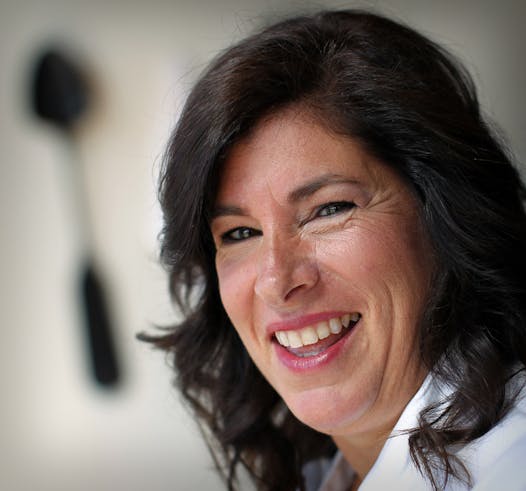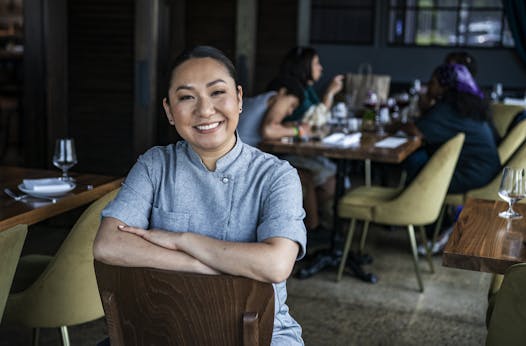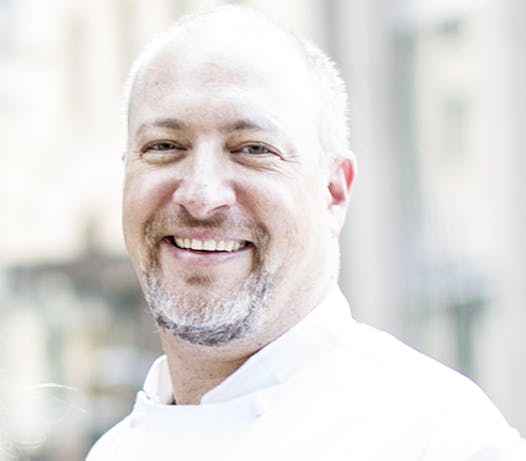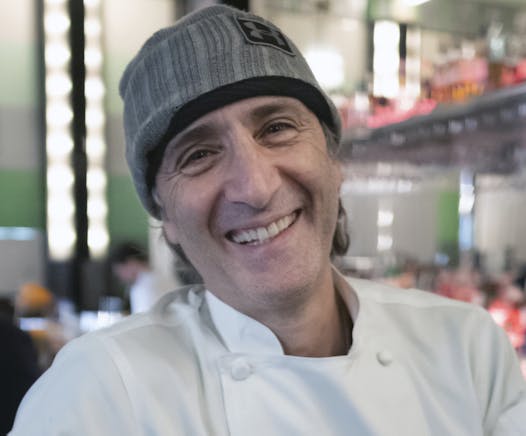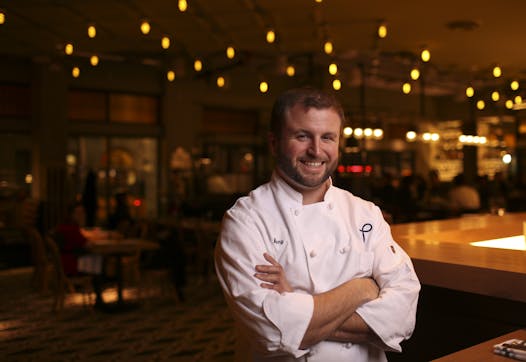The last time Tim McKee counted, his cookbook collection hovered somewhere in the neighborhood of 2,500 titles.
"And it never stops growing," he said. "I'm eventually going to have to get a bigger house."
The James Beard award-winning chef/owner of Octo Fishbar in St. Paul started what he calls his "obsession" during his early 1990s tenure at Azur in downtown Minneapolis. That's where McKee's mentor Jay Sparks would assign his kitchen staff the weekly task of presenting new menu items rooted in Mediterranean culinary traditions.
"It was a real challenge," said McKee. "Now, you can go on Google, and you can get a book in two days from Amazon. But then you'd have to go to the library and hope they had that one book on, say, Portuguese cooking. That kind of research direction from Jay forced us to have a sort of anthropological approach to learning about cooking."
He's been amassing cookbooks ever since. A favorite cookbook trend of McKee's is the increased illumination of previously little-explored world cuisines.
"Ten years ago, you wouldn't have seen many books on Middle Eastern cooking, period," he said. "Now, it's one of the hottest segments in cookbooks, and that's a pretty cool thing to see. Along those same lines, Paula Wolfert was the only one who ever wrote about Moroccan cuisine. Now, I'm looking and seeing that I have 14 — no, 15 — books on Moroccan cuisine, and that's pretty amazing to me."
Since his restaurant went dark in mid-March (he's also furloughed from his vice president position at the Fish Guys, a major Twin Cities seafood supplier), McKee has been spending a lot of time at home, cooking. And reading.
"For the past six weeks, these cookbooks have been my refuge," he said. That includes "The Whole Fish Cookbook" (2019) by Josh Niland.
"There are always a couple of books that I keep revisiting," he said. "'The Whole Fish Cookbook' is maybe the best cookbook from last year, in my opinion. It's pretty technical, and maybe not something that the average cook can pick up and do anything with. I've been butchering fish for 30 years, and after this book I found out that I don't know anything about it. It's an amazing book."
We asked seven other Twin Cities chefs and restaurateurs for the cookbooks that are currently capturing their imaginations.
"Flavorwalla" (2016) by Floyd Cardoz
"Because it was Passover, I was going through lots of old Jewish cookbooks. But this is another one that I've been going through and playing around with. I pulled it out because he just died of COVID-19, and that broke my heart. He was at Cooks of Crocus Hill four years ago and I took his class. It was in April, and I know that because I wrote that in the book. In the class, he was super-charming, he talked about his family, and how he felt like a failure because he was in the restaurant business and his parents wanted him to be something else. There's a recipe that I love that's for beets and fresh ricotta with I want to say orange. It's really great, and it feels like spring. I'm pretending that it's spring, whether it actually is or not." — Patti Soskin, Yum! Kitchen and Bakery in St. Louis Park and Minnetonka
"The Vanilla Bean Baking Book" (2016) by Sarah Kieffer
"I have a pretty big collection of cookbooks, but most of them are perfectly pristine because I never have the time to cook from them. I met the author — she's from Minnesota — when she was on a Cherry Bombe panel. That's when I bought the book; it was a few years ago. I wanted to bake something for my son's kindergarten teacher, and I remembered these cookies from the book, these pan-banging chocolate chip cookies, and I thought, 'What is all the fuss about?' While you're baking them, you've got to bang the pan of cookies about every two minutes, so they flatten out. They're time-consuming, because you can't just put them in the oven and walk away. But it totally works. I really like these cookies. They're ginormous. I think each cookie is something like a third of a cup of dough, and you bake them four to a pan, they're that big. This is an interesting time, and think that baking these cookies was a little escape from everything that's going on. I think we're all craving comfort, and we're going to have to lose weight when we come out of this." — Ann Ahmed, Lat14 in Golden Valley and Lemon Grass Thai Cuisine in Brooklyn Park
"Flour Water Salt Yeast" (2012) by Ken Forkish
"I have been cooking a ton. We had a lamb loin roast in the freezer from Hidden Stream Farm, so that's what we had last night. We all suffer quarantine in our own way. And like everybody else, I've been reading a lot about bread. I'm learning a lot. It's fun to take a deep dive into it, to take some time and educate myself about something that's maybe a little bit of a hole in my culinary repertoire. It's been years since I've made anything other than brioche. [Forkish, who owns Ken's Artisan Bakery in Portland, Ore.] has interesting techniques for baking at home, which is so different from commercial baking. I've got two different sourdough mothers going on my countertop, and I'm going to start with a levain that he's got in the book. I've also been making a lot of pizza lately because I have this craving for it, and as an unemployed person, I don't feel like I should be doing a lot of takeout." — Russell Klein, Meritage in St. Paul
"When French Women Cook" (2010) by Madeleine Kamman and "The Cook and the Gardener" (2000) by Amanda Hesser
"I've got a million cookbooks, and because I don't have a lot of experience baking bread, I've been getting into that, like everyone else. We've been making a lot of dinners and that has been fun. Nothing groundbreaking, but my kids love it. Everyone's at home, and we're having risotto, or fresh pasta, and that's something we used to only do on Sundays. I dug out 'When French Women Cook' because it has solid recipes. They're not groundbreaking, but they have techniques that you might not know about. It's a great book. There's a pork roast with a pistachio filling that has just six ingredients, and I love it. I also like 'The Cook and the Gardener' for the same reasons. It's all about seasonal cooking and focusing on the flavor of the ingredients. She has this whole duck recipe that has just a few ingredients, including Calvados and pears, and you really have to follow the technique, you have to baby it, but then it's so great. These are the kinds of books that make me like food, and cooking. It's the kind of cooking that inspires me." — Isaac Becker, 112 Eatery, Bar La Grassa, Burch Restaurant and Snack Bar, all in Minneapolis
"97 Orchard: An Edible History of Five Immigrant Families in one New York Tenement" (2010) by Jane Ziegelman
"This is a book that every person should read, because the immigrant food story is the American food story. It's about a German guy who buys a building on the Lower East Side in New York City and rents it to different families: Irish, Jewish, Italian. The only piece that's missing is that there are no Sephardic Jews in the building. I think we would have brought more spice and more history to it. Well, they're all cooking, and when you read it you're inspired by these stories to make all of these dishes. I grew up in a building like this in Morocco. This book speaks to me. It really reminds me of what cooking is all about. It's not about recipes. Cooking is about stories, it's about the senses, it's about culture. My dad used to say, 'I don't know if I remember the story because of the dish, or if I remember the dish because of the story.' Food is good because of the company that we share it with. When we go back to whatever the new normal is, and we look back at this time, I hope we'll all miss that we've been cooking and sitting around the table, eating and sharing stories." — David Fhima, Fhima's Minneapolis
"The Greens Cookbook" (1987) by Deborah Madison
"I'm really trying to focus on healthy, nutrient-dense food. For us, it's been looking for additional vegetable dishes beyond roasting cauliflower or carrots or parsnips. That brings me to my guilty pleasure: I love Goop [Gwyenth Paltrow's lifestyle brand]. A girlfriend got me 'The Clean Plate' last year, and it's pretty good. But in that same vegetarian vein, that's why I also pulled out 'Greens.' I went to Greens in 1997. It was my first trip to San Francisco, and the restaurant just made an imprint on me. I remember coming back and making some of the items at the Highland Grill, like a wilted spinach salad with red onion, kalamata olives, garlic and mint. The olive oil is hot — it's in the style of a warm bacon salad — and the kalamatas give it meatiness. It's good. That feels like it was so long ago, but the book is still relevant today." — Stephanie Shimp, the Blue Plate Restaurant Co., operators of Highland Grill and Groveland Tap in St. Paul, Edina Grill in Edina, 3 Squares Restaurant in Maple Grove and Longfellow Grill, the Lowry, the Freehouse and Mercury Dining Room and Rail in Minneapolis
"On Food and Cooking" (Scribner, 1984, revised 2004) by Harold McGee
It's almost more of a book about cooking than an actual cookbook. There are no real recipes in it, and it's one of the best books about cooking ever written. It helps you understand, from a scientific perspective, what's actually going on. I've been doing a lot of testing and menu development lately, and when I'm trying to get something to do what I want it to do, it's a really great resource. It's probably the most picked-up cooking book that I have. It's not an easy read; it's more like a textbook. It was one of the two main texts that we would reference in almost every class at the Culinary Institute of America, and I've loved it ever since. I love science and chemistry and physics — that's what I was studying in college — and this just kind of fits in with that. I think this is my fifth copy, because sometimes they get damaged, or I've given it away and got a new one. It's one of the books that I like to give away to young cooks." — Remy Pettus, Bardo, Minneapolis
Rick Nelson • @RickNelsonStrib
Roasted Beets With Orange and Fresh Ricotta
Serves 2.
Note: If desired, substitute two larger beets for four baby beets for both types of beets; if using larger beets, they may take longer to roast, up to 3 hours. If using commercially prepared ricotta, be sure to stir in the orange zest, orange juice, salt and pepper. From "Flavorwalla," by Floyd Cardoz.
For ricotta:
• 1 quart whole milk
• 1 c. buttermilk
• Freshly minced zest and juice from 1 large orange
• Kosher salt
• Freshly ground black pepper
For beets:
• 4 red baby beets, trimmed (see Note)
• 4 golden baby beets, trimmed (see Note)
• 1 tbsp. canola oil
• Kosher salt
• Freshly ground black pepper
• 1/4 c. freshly squeezed orange juice
• 1/4 c. extra-virgin olive oil
• 2 tbsp. red wine vinegar
• 4 drops Thai chile oil
• 1 tbsp. freshly peeled and minced ginger
• 1/2 c. diced red onion
• 2 c. arugula
Directions
To prepare ricotta: In a medium saucepan over very low heat, blend milk and buttermilk and cook, stirring occasionally so that the bottom of the pan does not scorch, until the mixture reaches 110 degrees on an instant-read thermometer. Increase heat slightly and continue to cook, stirring occasionally, until the mixture reaches 175 degrees. Remove pan from heat and set aside to cool until curds form, about 5 minutes.
Line a colander with several layers of cheesecloth and set it over a bowl. Use a spoon to skim the curds from the whey (liquid) and place them over the colander. Let stand at room temperature until completely cooled.
Transfer the drained ricotta to another bowl (discard the whey left behind). Stir in the orange zest and juice and season to taste with salt and pepper. Set aside if serving within a few hours, or refrigerate for up to 5 days.
To prepare beets: Preheat oven to 350 degrees.
Place the red beets in 1 medium bowl and the golden beets in another. Drizzle with canola oil, season with salt and pepper and toss to coat. Wrap the beets in 2 separate foil packs. Place the packs on a baking sheet and roast until the beets are tender when pierced with a paring knife, about 45 to 60 minutes (if beets are very fresh, check at 30 minutes, as they may cook very quickly. Remove from oven and unwrap them, and while beets are still hot, rub off the skin with paper towels. Cut beets into 1-inch pieces and transfer to a large bowl.
In a small bowl, whisk together the orange juice, olive oil, vinegar, chile oil, ginger and salt and pepper. Pour mixture over the beets and toss to coat. Set beets aside to marinate at room temperature for at least 1 hour, or refrigerate for up to 24 hours.
Just before serving, add the onion to the beets and toss to combine. Taste for seasoning.
Place the arugula on a serving platter and spoon the beets and all the marinade over the salad. Place several spoonfuls of ricotta on top or place the ricotta in a bowl on the side. Serve.
Nutrition information per serving:
Calories720Fat45 gSodium560 mg
Carbohydrates59 gSaturated fat14 gAdded sugars0 g
Protein24 gCholesterol55 mgDietary fiber7 g
Exchanges per serving: 2 ½ milk, 1 starch, 1 carb, 9 fat.
Wilted Spinach Salad
Serves 4 to 6.
Note: From "The Greens Cook Book," by Deborah Madison.
• 1 small red onion, quartered and thinly sliced
• 3 to 4 slices baguette per person, for croutons
• 6 tbsp. olive oil, divided
• 8 to 12 kalamata olives
• 1 lb. bunch of spinach
• 1 garlic clove, finely chopped
• 1 tbsp. fresh mint leaves, finely chopped
• 2 tbsp. sherry vinegar
• 6 oz. feta cheese
Directions
Preheat oven to 400 degrees. Cover onion slices with cold water and refrigerate until needed. Brush bread with some of the olive oil and toast it in the oven until it is crisp and lightly browned, 6 to 8 minutes. Press olives to split them open, take out the pits, and cut or tear the meats in two.
Remove spinach stems (or not, as you prefer) and discard any bruised or yellow leaves. Cut the large leaves into halves or thirds; small leaves can be left whole. Wash the spinach, using 2 changes of water if the spinach is very sandy, and spin dry.
When ready to make the salad, drain the onions. Put the spinach in a large metal bowl and toss with the onions, garlic, mint, olives and vinegar. Break up the cheese and crumble over the spinach.
In a small pan over medium heat, warm the remaining olive oil until very hot, but just short of smoking. Immediately pour over the salad, turning the leaves with a pair of metal tongs so that the hot oil coats and wilts as many leaves as possible. Season with more vinegar if needed. Serve with the croutons tucked in and around the leaves.
Variation: Instead of using only spinach, combine it with curly endive, escarole or thinly sliced red cabbage — all greens that respond well to being prepared in this way.
Nutrition information per each of 6 servings:
Calories290Fat21 gSodium560 mg
Carbohydrates18 gSaturated fat6 gAdded sugars0 g
Protein8 gCholesterol25 mgDietary fiber2 g
Exchanges per serving: 1 starch, 1 high-fat protein, 3 fat.
Chocolate Chip Cookies
Makes 10 large cookies.
Note: From "The Vanilla Bean Baking Book," by Sarah Kieffer.
• 2 c. flour
• 1/2 tsp. baking soda
• 3/4 tsp. salt
• 1 c. (2 sticks) unsalted butter, at room temperature
• 1 1/2 c. granulated sugar
• 1/4 c. packed brown sugar
• 1 egg
• 1 1/2 tsp. vanilla extract
• 6 oz. bittersweet chocolate (about 60% cacao solids), chopped into coarse pieces, bits and shards
Directions
Adjust an oven rack to the middle position. Preheat oven to 350 degrees and line 3 baking sheets with parchment paper.
In a small bowl, whisk together flour, baking soda and salt, and reserve.
In a bowl of an electric mixer on medium speed, beat butter until creamy. Add granulated sugar and brown sugar and beat until light and fluffy, about 2 to 3 minutes. Reduce speed to low and add egg, vanilla extract and 2 tablespoons water, and mix until combined. Add flour mixture and mix until combined. Stir in chocolate. (At this point, dough can be refrigerated overnight. If dough is refrigerated overnight, skip the freezer instructions that follow.)
Form dough into 3 1/2-ounce balls, a heaping 1/3 cup each. Place 4 dough balls an equal distance apart on a prepared baking sheet, and transfer baking sheet to the freezer for 15 minutes before baking. (After you put the first baking sheet in the oven, put the second one in the freezer.)
Place the chilled baking sheet in the oven and bake 10 minutes, until cookies are puffed slightly in the center.
Lift the baking sheet up about 4 inches and let it gently drop down against the oven rack, so the edges of the cookies set and the inside falls back down. (This will feel wrong, but it's not.) Bang the baking sheet down, if necessary, to make the centers fall.
After the cookies puff up again, 2 to 3 minutes later, repeat lifting and dropping the baking sheet. Repeat a few more times, every 2 to 3 minutes, to create ridges around the cookies' edge. Bake until cookies have spread out and the edges are golden brown, but the centers are much lighter and not fully cooked, about 16 to 18 minutes in total.
Remove from oven and transfer the baking sheet to a wire rack. Cool cookies completely before removing the cookies from the baking sheet.
Nutrition information per serving:
Calories500Fat26 gSodium250 mg
Carbohydrates64 gSaturated fat15 gAdded sugars41 g
Protein4 gCholesterol70 mgDietary fiber2 g
Exchanges per serving: 1 starch, 3 carb, 5 fat.
Chasing 'Twisters' and collaborating with 'tornado fanatic' Steven Spielberg

